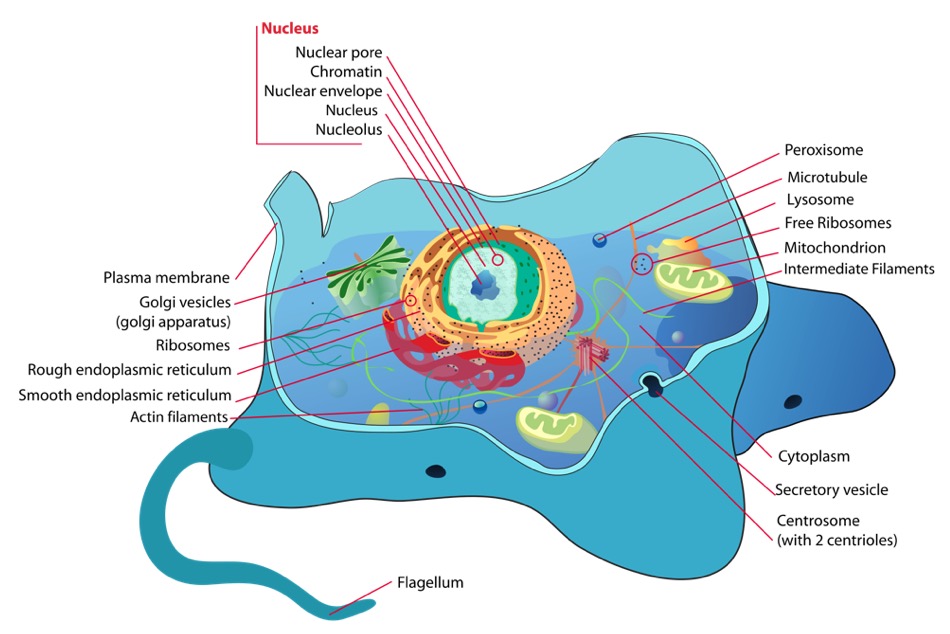Playlist
Show Playlist
Hide Playlist
Mitochondria and Origins of Eukaryotic Cells
-
Slides 06 CellularStructure CellBiology.pdf
-
Reference List Molecular and Cell Biology.pdf
-
Download Lecture Overview
00:00 Finally we need to look at our other membrane bound organelles. 00:05 Mitochondria are the ones that we'll focus on in cells for this course because those are found in animal cells. 00:12 Chloroplasts also come about in a very similar way and have quite similar structure but they are in plant cells. 00:19 The mitochondria has some specific anatomy that we need to look at because later in the course we will look at how cellular respiration occurs. 00:30 And it involves understanding the structure of mitochondria. 00:34 So mitochondria have an outer cell membrane as well as an inner cell membrane. 00:39 We call the space between those membranes the intermembrane space. 00:45 And then the space all the way in the middle, we call the matrix. 00:50 Floating around in the matrix, which is sort of the soup inside the mitochondria, we will find both ribosomes because mitochondria can actually produce some of their own proteins we'll come to that in a little bit, as well as some DNA. DNA molecules are circular DNA, very much like prokaryotic DNA. 01:13 And that's going to lead us into talking about where these membrane bound organelles may have come from. 01:21 So I had introduced earlier in this lecture the idea that membranes came, these compartmentalization came from membrane invagination. 01:32 That would be called the endomembrane theory. 01:34 Now, how did these other organelles perhaps make their way into becoming organelles inside of a eukaryotic cell. 01:45 Recall eukaryotic cells. They're about ten times larger than prokaryotic cells. 01:50 And it's proposed that things like the nucleus and mitochondria may have arisen from other prokaryotic cells becoming enveloped or endocytosed, pulled in like food, into larger prokaryotic cells. 02:05 The nucleus could have arisen this way. The mitochondria could have arisen this way. 02:10 And chloroplast could have arisen this way. 02:12 Now keep in mind that all three of these organelles have DNA of their own in them. 02:20 The DNA in the nucleus has changed significantly. 02:23 However, the DNA in chloroplast and mitochondria are still single circular molecules or plasmids of DNA that we'll see inside of those. 02:35 So it's likely that they have this double membrane structure because they were essentially swallowed up by a larger cell. 02:43 And perhaps, they had more ribosomes in them, or perhaps, they were able to make more ATP and that became a successful strategy and so eukaryotic cells could have come about this way. 02:56 So the endomembrane theory, and endosymbiotic theory are both ideas about how eukaryotic cells could have arisen from prokaryotic cells. 03:08 And I think it's important to discuss that because it helps us remember that the mitochondria have some of their own DNA as well as ribosomes of their own that look like prokaryotic DNA. 03:23 So in closing this lecture, we've explored nuclear structure. 03:28 So now you should be able to explain the structure of a nucleus, including some basket anatomy and how they control flow of things in and out of the nucleus, as well as being able to describe the roles of each of the organelles in the endomembrane transport system. 03:46 How do we make proteins to go. 03:47 And finally, we covered how eukaryotic cells could have become so much more complex than prokaryotic cells. 03:58 So I'd thank you for your attention and I look forward to seeing you again in the future lecture.
About the Lecture
The lecture Mitochondria and Origins of Eukaryotic Cells by Georgina Cornwall, PhD is from the course Cellular Structure.
Included Quiz Questions
Which of the following are true about mitochondria? Select all that apply.
- They are surrounded by a double membrane.
- According to the endosymbiotic theory, they likely originated due to a larger cell engulfing smaller prokaryotic cells.
- They have their own DNA and ribosomes that appear to be of prokaryotic origin.
- They are the powerhouse of the cell because they are the site of cellular respiration.
- They are a part of the endomembrane system.
Which statement is CORRECT with respect to endosymbiotic theory?
- Mitochondria likely originated from prokaryotic cells.
- Cytoplasmic membranes originated from fungi.
- DNA molecules in mitochondria are linear.
- The nucleus and mitochondria are integral organelles of prokaryotic cells.
- Eukaryotes replicate by clonal proliferation.
Customer reviews
5,0 of 5 stars
| 5 Stars |
|
1 |
| 4 Stars |
|
0 |
| 3 Stars |
|
0 |
| 2 Stars |
|
0 |
| 1 Star |
|
0 |
The way of teaching of Georgina is really impresive, i understanded everything. The best classes ever.





